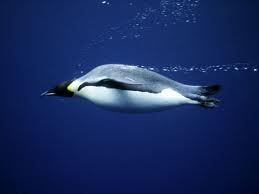Picture a Submarine with the Wings of a Penguin
Now researchers are looking into a propulsion system based on the wings of the penguin which essentially flies through the waters of the Antarctic in search of food. What is remarkable is that Emperor penguins have the ability to accelerate from a dead start to 15.6 miles per hour in less than one second.
Back in 1991, the science magazine Nature published a picture from the IMAX movie Antarctica, along with the caption: "Emperor penguins may be waddling jokes on land, but underwater they can turn into regular rockets…accelerating from 0 to 7 m/s in less than a second."
That's all it took to inspire Flavio Noca, a graduate student in Caltech's Aeronautics Department who now teaches aerodynamics at the Swiss Federal Institute of Technology (EPFL), to explore leveraging penguins' "rocket" properties to create new propulsion technologies with high maneuverability and improved hydrodynamic efficiency.
At the American Physical Society's (APS) Division of Fluid Dynamics meeting, Nov. 24 -- 26, in Pittsburgh, Pa, Noca will present a penguin-inspired propulsion system that uses a novel spherical joint mechanism based on a penguin's shoulder-and-wing system. The mechanism features a spherical joint that enables three degrees of freedom and a fixed center of rotation. "Unlike an animal shoulder joint, however, this spherical joint enables unlimited rotational range about the main shaft axis like a propeller," Noca said.
To achieve this they needed to overcome the technical challenges of spherical joints, such as the lack of rigidity and the inability to generate high torques. To understand the challenge involved, just try lifting a 10-pound weight on your hand with your arm extended.
The manner in which penguins swim is still poorly understood, aside from the technological perspective, according to Noca. "By accurately reproducing an actual penguin wing movement, we hope to shed light on the swimming mysteries of these underwater rockets," he said.
And some submarine designer, somewhere, is paying close attention to this research ~ as are any number of Sci-Fi authors looking for the technology of the next Red October.
* * * * *
Wired for Story: The Writer's Guide to Using Brain Science to Hook Readers from the Very First Sentence
 by Lisa Cron
by Lisa Cron

Story Source: Based on materials provided by American Physical Society, via Newswise, (2013, November 14). Penguin-inspired propulsion system. ScienceDaily.


Comments
Post a Comment